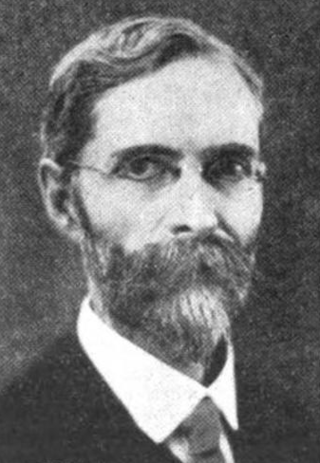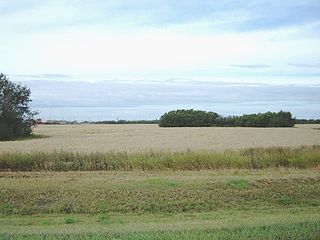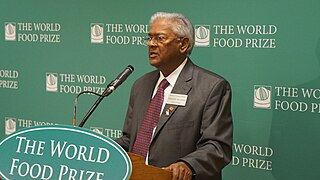Related Research Articles

Wheat is a grass widely cultivated for its seed, a cereal grain that is a worldwide staple food. The many species of wheat together make up the genus Triticum ; the most widely grown is common wheat. The archaeological record suggests that wheat was first cultivated in the regions of the Fertile Crescent around 9600 BC. Botanically, the wheat kernel is a caryopsis, a type of fruit.

Sir Charles Edward Saunders, was a Canadian agronomist. He was the inventor of the 'Marquis' wheat cultivar. Saunders Secondary School in London, Ontario is named for him and other members of his prominent family, including his father, agriculturist William Saunders and naturalist brother William Edwin Saunders.

Stem rust, also known as cereal rust, black rust, red rust or red dust, is caused by the fungus Puccinia graminis, which causes significant disease in cereal crops. Crop species that are affected by the disease include bread wheat, durum wheat, barley and triticale. These diseases have affected cereal farming throughout history. The annual recurrence of stem rust of wheat in North Indian plains was discovered by K.C. Mehta. Since the 1950s, wheat strains bred to be resistant to stem rust have become available. Fungicides effective against stem rust are available as well.

Wheat leaf rust is a fungal disease that affects wheat, barley, rye stems, leaves and grains. In temperate zones it is destructive on winter wheat because the pathogen overwinters. Infections can lead up to 20% yield loss. The pathogen is a Puccinia rust fungus. It is the most prevalent of all the wheat rust diseases, occurring in most wheat-growing regions. It causes serious epidemics in North America, Mexico and South America and is a devastating seasonal disease in India. P. triticina is heteroecious, requiring two distinct hosts.

Canada is one of the largest agricultural producers and exporters in the world. As with other developed nations, the proportion of the population agriculture employed and agricultural GDP as a percentage of the national GDP fell dramatically over the 20th century, but it remains an important element of the Canadian economy. A wide range of agriculture is practised in Canada, from sprawling wheat fields of the prairies to summer produce of the Okanagan valley. In the federal government, overview of Canadian agriculture is the responsibility of the Department of Agriculture and Agri-Food.

Elvin Charles Stakman was an American plant pathologist who was a pioneer of methods of identifying and combatting disease in wheat. He became an internationally renowned phytopathologist for his studies of the genetics and epidemiology of stem rust. Stakman is credited with improving crop yields both in North America and worldwide as part of the Green Revolution.

Agriculture in Saskatchewan is the production of various food, feed, or fiber commodities to fulfill domestic and international human and animal sustenance needs. The newest agricultural economy to be developed in renewable biofuel production or agricultural biomass which is marketed as ethanol or biodiesel. Plant cultivation and livestock production have abandoned subsistence agricultural practices in favor of intensive technological farming resulting in cash crops which contribute to the economy of Saskatchewan. The particular commodity produced is dependent upon its particular biogeography or ecozone of Geography of Saskatchewan. Agricultural techniques and activities have evolved over the years. The first nation nomadic hunter-gatherer lifestyle and the early immigrant ox and plow farmer proving up on his quarter section of land in no way resemble the present farmer operating huge amounts of land or livestock with their attendant technological mechanization. Challenges to the future of Saskatchewan agriculture include developing sustainable water management strategies for a cyclical drought prone climate in south western Saskatchewan, updating dryland farming techniques, stabilizing organic definitions or protocols and the decision to grow, or not to grow genetically modified foods. Domestically and internationally, some commodities have faced increased scrutiny from disease and the ensuing marketing issues.

Red Fife wheat is a Canadian landrace descendant of wheat from Galicia, Eastern Europe, its old local Galician name being "Halychanka". It is a hard, bread wheat with straws 0.9 to 1.5 metres tall.

David Alexander Fife (1805–1877) was a Scottish-born Canadian farmer credited with developing the variety of wheat which later became known as Red Fife.
Mutation breeding, sometimes referred to as "variation breeding", is the process of exposing seeds to chemicals, radiation, or enzymes in order to generate mutants with desirable traits to be bred with other cultivars. Plants created using mutagenesis are sometimes called mutagenic plants or mutagenic seeds.

Margaret Brown Newton was a Canadian plant pathologist and mycologist internationally renowned for her pioneering research in stem rust Puccinia graminis, particularly for its effect on the staple Canadian agricultural product wheat.
Cyril Harold Goulden was an eminent Welsh/Canadian geneticist, statistician and agronomist who earned his PhD at the University of Minnesota under the supervision of Herbert Kendall Hayes. He also studied briefly with Ronald Fisher at Rothamsted Experimental Station.

Dr. Sanjaya Rajaram was an Indian-born Mexican scientist and winner of the 2014 World Food Prize. He was awarded this prize for his scientific research in developing 480 wheat varieties that have been released in 51 countries. This innovation has led to an increase in world wheat production – by more than 200 million tons – building upon the successes of the Green Revolution. The Government of India awarded him India's fourth- and third-highest civilian awards Padma Shri (2001) and Padma Bhushan (2022).
Applecrabs are various hybrids between crabapples and apples. They are bred for varying reasons, including disease resistance and use in cold climates because they are often hardier than apple trees and their fruit has the good eating qualities of apples.
The Cereal Research Centre was a research institute established in 1925 based at the University of Manitoba in Winnipeg. It became part of a national network of research centres operated by Agriculture and Agri-Food Canada. Its research led to the development of over two hundred varieties of plant species resistant to pests and blights and producing high yields suitable for cultivation in the Canadian Prairies.
Isabella Preston was a horticulturist and public servant widely recognized for her achievements in plant hybridization and extensive work in ornamental plant breeding. She is Canada’s first female professional plant breeder. During her 26-year career, she produced nearly 200 new hardy hybrids of lily, lilac, crab apple, iris and rose plants for Canada's cold climate. While female plant breeders were rather rare in her day, she quietly challenged gender bias and set the stage for new generations of breeding programs at the Central Experimental Farm in Ottawa, Ontario, Canada and elsewhere.

The 'Marquis' bread wheat cultivar was developed by Dominion Agriculturalist Charles Saunders in 1904. It is a cross between Red Fife and Hard Red Calcutta. It was selected for superiority in milling quality for bread flour over other cultivars then prevalent in western Canada. 'Marquis' had the advantage of maturing 10 days earlier than its competitors – a factor of great importance in the Canadian wheatbelt such as Alberta, Manitoba and Saskatchewan, extending as far south as southern Nebraska.
Diane G. O. Saunders is a British biologist and group leader at the John Innes Centre and an Honorary Professor in the School of Biological Sciences at the University of East Anglia. Her research investigates plant pathogens that pose a threat to agriculture. She was awarded the Rosalind Franklin Award by the Royal Society in 2022.
Ralph Merrill Caldwell was an American plant breeder, mycologist, and plant pathologist. Through his work with the U.S. Department of Agriculture and Purdue University, he developed disease-resistant cultivars for a wide variety of plants, including widely-grown wheat cultivars.
References
- ↑ "Red Fife Wheat", The Canadian Encyclopedia, Historica Canada, 2013, retrieved 11 July 2015
- ↑ http://www.grassrootsolutions.com/heritage-wheat/varieties.html, Sharon Rempel Grassroot Solutions, Heritage Wheat Varieties, Retrieved September 4, 2010.
- ↑ http://www.seeds.ca/proj/hwp/index.php?n=variety_cdn Archived 2011-07-27 at the Wayback Machine , Heritage Wheat Project, Canadian Heritage Wheat Varieties, Retrieved September 4, 2010.
- 1 2 Natural systems agriculture, Cultivar Mixtures, Cover Crops, and Intercropping with Organic Spring Wheat, The Cultivar Mixture Trial , retrieved 11 July 2015